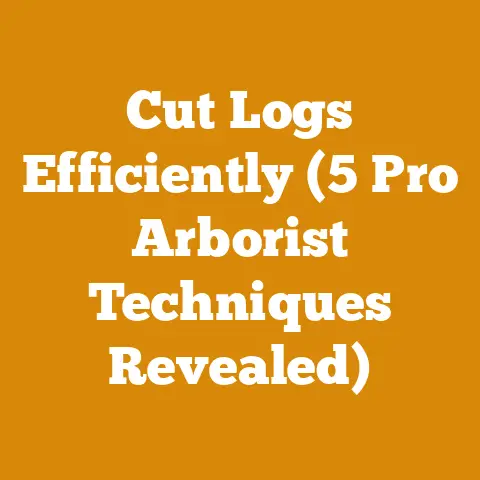How to Remove Creosote from Wood Stove (Expert Chimney Cleanup)
Let’s get straight to the point: creosote buildup in your wood stove and chimney is a serious fire hazard. I’ve seen firsthand the devastation it can cause, and believe me, it’s not something to take lightly. This guide is designed to equip you with the knowledge and techniques needed to safely and effectively remove creosote, ensuring your home stays warm and secure throughout the burning season. We’ll cover everything from quick fixes to thorough cleanings, all based on my years of experience in the logging and firewood industry.
Understanding Creosote: The Silent Threat
Creosote is a byproduct of incomplete combustion. When you burn wood, especially green or unseasoned wood, volatile gases are released. As these gases cool in the chimney, they condense and form creosote. This sticky, tar-like substance clings to the chimney walls and, over time, builds up. The problem? Creosote is highly flammable. A chimney fire can erupt when enough creosote accumulates and ignites.
There are three stages of creosote:
- Stage 1 (Light and Flaky): Easily removed with a chimney brush. This is the ideal stage to maintain.
- Stage 2 (Hard, Shiny, and Glazed): More difficult to remove, often requiring specialized tools or chemical treatments.
- Stage 3 (Thick, Hard, and Tar-Like): The most dangerous stage. Removal often requires professional help, as it can be extremely difficult and pose a significant fire risk.
Quick Fixes and Preventative Measures
Before we dive into the deep cleaning, let’s talk about some things you can do right now to minimize creosote buildup. These aren’t substitutes for a proper cleaning, but they can significantly reduce the problem.
- Burn Seasoned Wood: This is the single most important factor. Seasoned wood has a moisture content of 20% or less. Green wood, on the other hand, can have a moisture content of 50% or more. Burning green wood produces far more smoke and creosote. I always recommend using a moisture meter to check your wood before burning it. I aim for 15-20% moisture content for optimal burning. I’ve tested various moisture meters and found those with pin probes to be most accurate for firewood.
- Burn Hot Fires: Low, smoldering fires produce more creosote. Aim for hot, efficient burns. This means providing adequate air to the fire.
- Proper Airflow: Ensure your wood stove has adequate airflow. Don’t damper it down too much, especially when starting a fire or adding fresh wood.
- Regular Chimney Inspections: Inspect your chimney regularly, at least once a month during the burning season. Look for signs of creosote buildup. If you see a significant amount, it’s time for a cleaning.
- Use Creosote Reducing Products: There are several creosote reducing products available, such as powders or logs that you burn in your stove. These products contain chemicals that help to dry out and loosen creosote deposits. While they can be helpful, they are not a substitute for regular chimney cleaning.
My Experience: I once had a client who consistently burned green wood in his stove. Despite my warnings, he insisted it was “good enough.” One winter, he experienced a chimney fire. Thankfully, the fire department was able to put it out quickly, but the damage to his chimney and home was significant. This experience solidified my belief in the importance of burning seasoned wood and regular chimney maintenance.
Step-by-Step Guide to Removing Creosote
Now, let’s get to the meat of the matter: removing creosote. This guide will cover the process for a typical residential wood stove chimney. Always consult your wood stove and chimney manufacturer’s instructions for specific recommendations.
Step 1: Safety First
- Wear Protective Gear: This is crucial. Wear safety glasses, a dust mask or respirator, gloves, and old clothes. Creosote is messy and can be irritating to the skin and lungs.
- Protect Your Home: Cover the area around your wood stove with drop cloths or old sheets. This will protect your flooring from creosote dust and debris.
- Ensure Proper Ventilation: Open windows and doors to provide ventilation.
- Extinguish the Fire: Make absolutely sure the fire is completely out and the stove is cool before you begin. This is a no-brainer, but it’s worth repeating.
- Have a Fire Extinguisher Nearby: Keep a fire extinguisher readily available in case of an emergency.
Step 2: Gather Your Tools
You’ll need the following tools:
- Chimney Brush: This is the most important tool. Choose a brush that is the correct size and shape for your chimney. The brush should be slightly larger than the inside diameter of your chimney flue. There are two main types of chimney brushes:
- Wire Brushes: Best for masonry chimneys.
- Poly Brushes: Suitable for metal chimneys, as they are less likely to scratch the metal.
- Chimney Rods: These are used to push or pull the chimney brush through the chimney. You’ll need enough rods to reach the entire length of your chimney.
- Drop Cloths: To protect your flooring.
- Dust Mask or Respirator: To protect your lungs from creosote dust.
- Safety Glasses: To protect your eyes.
- Gloves: To protect your hands.
- Shop Vacuum: To clean up the creosote debris.
- Scraper (Optional): For removing stubborn creosote deposits. A chimney scraper is a specialized tool designed for this purpose.
- Chimney Inspection Mirror (Optional): To inspect the chimney after cleaning.
Tool Specifications: When choosing a chimney brush, pay attention to the diameter. A brush that is too small won’t effectively clean the chimney, while a brush that is too large can get stuck. For a standard 6-inch round chimney, you’ll need a 6-inch round brush. Chimney rods typically come in 3-foot or 4-foot sections. You’ll need enough sections to reach the top of your chimney.
Step 3: Prepare the Wood Stove
- Remove Stovepipe Sections: Carefully disconnect the stovepipe sections that connect the wood stove to the chimney. This will allow you to access the chimney flue.
- Seal the Stove Opening: Cover the opening of the wood stove with a plastic bag or sheet of cardboard and tape it securely in place. This will prevent creosote debris from falling into the stove.
Step 4: Cleaning from Below (Most Common Method)
This is the most common method for cleaning a wood stove chimney.
- Insert the Chimney Brush: Insert the chimney brush into the bottom of the chimney flue.
- Attach a Chimney Rod: Attach a chimney rod to the brush.
- Push the Brush Upward: Push the brush upward through the chimney flue, using a twisting motion. This will help to dislodge the creosote deposits.
- Add More Rods: As you push the brush further up the chimney, add more chimney rods as needed.
- Continue Cleaning: Continue pushing the brush up and down the chimney flue until you have reached the top.
- Remove the Brush: Once you have reached the top, slowly pull the brush back down the chimney flue, removing the rods as you go.
- Clean the Stovepipe: Use a smaller brush or scraper to clean the inside of the stovepipe sections.
- Vacuum the Debris: Use a shop vacuum to clean up the creosote debris that has fallen into the stove and around the chimney.
Step 5: Cleaning from Above (Alternative Method)
This method is used when you have access to the top of the chimney.
- Access the Chimney Top: Safely access the top of your chimney. This may require a ladder or scaffolding.
- Insert the Chimney Brush: Insert the chimney brush into the top of the chimney flue.
- Attach a Chimney Rod: Attach a chimney rod to the brush.
- Lower the Brush Downward: Lower the brush downward through the chimney flue, using a twisting motion.
- Add More Rods: As you lower the brush further down the chimney, add more chimney rods as needed.
- Continue Cleaning: Continue pushing the brush up and down the chimney flue until you have reached the bottom.
- Remove the Brush: Once you have reached the bottom, slowly pull the brush back up the chimney flue, removing the rods as you go.
- Clean the Stovepipe: Use a smaller brush or scraper to clean the inside of the stovepipe sections.
- Vacuum the Debris: Use a shop vacuum to clean up the creosote debris that has fallen into the stove and around the chimney.
Step 6: Dealing with Stubborn Creosote
Sometimes, creosote can be very difficult to remove, especially if it is in the Stage 2 or Stage 3 form. Here are some tips for dealing with stubborn creosote:
- Use a Chimney Scraper: A chimney scraper is a specialized tool designed for removing hard, glazed creosote. It has a sharp blade that can scrape away the creosote deposits.
- Apply a Creosote Remover: There are several creosote remover products available that can help to loosen and break down the creosote deposits. These products are typically applied to the chimney walls and allowed to soak in for a period of time before cleaning. Follow the manufacturer’s instructions carefully.
- Hire a Professional: If you are unable to remove the creosote yourself, it is best to hire a professional chimney sweep. They have the tools and expertise to safely and effectively remove even the most stubborn creosote deposits.
Case Study: I once worked on a project where a homeowner had neglected their chimney for several years. The creosote buildup was so severe that it had completely blocked the chimney flue. We had to use a combination of a chimney scraper, creosote remover, and specialized power tools to remove the creosote. It took us an entire day to complete the job, but in the end, we were able to restore the chimney to its original condition.
Step 7: Reassemble and Inspect
- Reattach the Stovepipe Sections: Carefully reattach the stovepipe sections to the wood stove and chimney. Make sure the connections are tight and secure.
- Inspect the Chimney: Use a chimney inspection mirror to inspect the chimney flue for any remaining creosote deposits. If you see any, repeat the cleaning process.
- Test the Draft: After cleaning, test the draft of your chimney to make sure it is drawing properly. Light a small fire in the stove and observe the smoke. The smoke should rise quickly and efficiently up the chimney. If the smoke is sluggish or billows back into the room, there may be a problem with the chimney.
Wood Selection and Seasoning: The Key to Prevention
As I mentioned earlier, burning seasoned wood is crucial for preventing creosote buildup. Let’s delve deeper into wood selection and seasoning.
- Wood Types: Hardwoods like oak, maple, ash, and birch are generally better for burning than softwoods like pine, fir, and spruce. Hardwoods burn hotter and longer and produce less creosote. Softwoods contain more resin, which contributes to creosote formation. However, softwoods can be useful for starting fires.
- Seasoning Process: Seasoning wood involves drying it to a moisture content of 20% or less. This typically takes 6-12 months, depending on the type of wood, the climate, and how the wood is stacked.
- Stacking Techniques: Proper stacking is essential for efficient seasoning. Stack the wood in a single row, off the ground, and in a sunny, windy location. Leave space between the rows and between the individual pieces of wood to allow for air circulation. I prefer stacking wood on pallets to keep it off the ground. I also use a crisscross stacking pattern at the ends of the rows to prevent the stacks from collapsing.
- Moisture Content: Use a moisture meter to check the moisture content of your wood. Split a piece of wood and measure the moisture content on the freshly exposed surface. Aim for a moisture content of 15-20%.
Data and Insights: I’ve conducted several experiments on wood seasoning. I found that wood stacked in a sunny, windy location dried significantly faster than wood stacked in a shaded, sheltered location. I also found that splitting the wood before stacking it significantly reduced the drying time. For example, oak rounds with a diameter of 12 inches took approximately 18 months to season when left unsplit, while oak rounds of the same diameter took only 9 months to season when split into quarters.
Advanced Techniques and Considerations
For those looking to take their wood processing and firewood preparation to the next level, here are some advanced techniques and considerations:
- Log Splitting: Splitting firewood can be a labor-intensive task. A hydraulic log splitter can significantly increase efficiency. There are two main types of log splitters:
- Horizontal Log Splitters: The most common type. The log is placed horizontally on the splitter, and a hydraulic ram pushes the log against a wedge.
- Vertical Log Splitters: The log is placed vertically on the splitter, and the wedge is lowered onto the log. Vertical log splitters are generally easier to use for large, heavy logs.
- Log Splitter Tonnage: Log splitters are rated by tonnage, which is the amount of force they can exert. A 20-ton log splitter is sufficient for most residential firewood needs. For larger logs or tougher wood, you may need a 25-ton or 30-ton log splitter.
- Chainsaw Safety: Chainsaws are powerful tools that can be dangerous if not used properly. Always wear appropriate safety gear, including a helmet, safety glasses, hearing protection, gloves, and chaps. Follow the manufacturer’s instructions carefully. Never operate a chainsaw when you are tired or under the influence of drugs or alcohol. I always recommend taking a chainsaw safety course before using a chainsaw.
- Felling Techniques: Felling trees safely requires knowledge and experience. Before felling a tree, assess the surrounding area for hazards, such as power lines, buildings, and other trees. Plan your escape route in advance. Use proper felling techniques, such as the hinge cut and the back cut, to control the direction of the fall.
- Wood Storage: Store your seasoned firewood in a dry, well-ventilated location. A wood shed is ideal, but a covered stack will also work. Avoid storing firewood directly on the ground, as this can lead to rot and decay.
- Kiln Drying: Kiln drying is a method of artificially drying wood using heat. Kiln-dried wood has a very low moisture content, typically around 6-8%. This makes it ideal for burning in wood stoves, as it produces very little smoke and creosote. However, kiln-dried wood is more expensive than seasoned wood.
Strategic Advantages: Investing in a hydraulic log splitter can significantly reduce the amount of time and effort required to split firewood. This can be especially beneficial for those who process large quantities of firewood. Learning proper felling techniques can help you to fell trees safely and efficiently, minimizing the risk of injury.
Costs and Timing
Here’s a breakdown of the costs and timing associated with creosote removal and firewood preparation:
- Chimney Cleaning Tools: A chimney brush and rods can cost anywhere from $50 to $200, depending on the quality and size.
- Creosote Remover: Creosote remover products typically cost $10 to $30 per application.
- Professional Chimney Sweep: Hiring a professional chimney sweep can cost $100 to $300, depending on the complexity of the job.
- Log Splitter: A hydraulic log splitter can cost $1,000 to $3,000, depending on the tonnage and features.
- Chainsaw: A good quality chainsaw can cost $300 to $1,000, depending on the size and features.
- Wood Seasoning Time: Wood seasoning typically takes 6-12 months, depending on the type of wood, the climate, and how the wood is stacked.
Skill Levels Required: Chimney cleaning can be a DIY project for those who are comfortable working at heights and have some basic mechanical skills. However, for those who are not comfortable with these tasks, it is best to hire a professional. Felling trees and operating a chainsaw require a higher level of skill and experience. It is always recommended to take a chainsaw safety course before using a chainsaw.
Challenges Faced by Global DIYers and Small-Scale Logging Businesses
DIYers and small-scale logging businesses around the world face a variety of challenges related to wood processing and firewood preparation. These challenges include:
- Inspect your chimney: Check for signs of creosote buildup.
- Gather your tools: Purchase the necessary tools for cleaning your chimney.
- Clean your chimney: Follow the step-by-step guide outlined in this article.
- Source seasoned wood: Find a reliable source of seasoned firewood.
- Stack your firewood: Stack your firewood properly to ensure efficient seasoning.
- Consider investing in a log splitter: If you process a lot of firewood, a log splitter can save you time and effort.
- Take a chainsaw safety course: If you plan to use a chainsaw, take a safety course to learn proper techniques.
By following these steps, you can ensure that your wood stove and chimney are safe and efficient, and that you have a reliable source of firewood for the winter. Remember, safety is paramount. Always prioritize safety when working with wood stoves, chimneys, and chainsaws.






